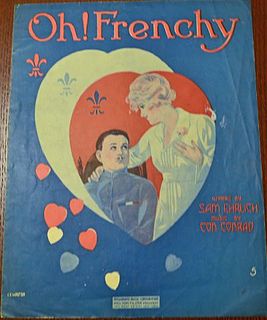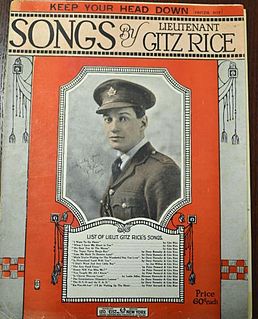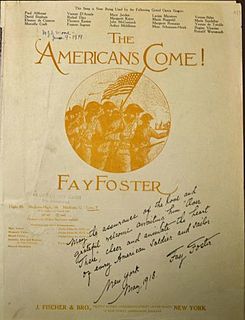There's a Garden of Crosses in No Man's Land is a World War I song written by William Robinson and composed by Gus Wackrow. The song was published in 1918 by the Elite Publishing Company in Boston, MA.
"We're Going Over the Top" is a World War I song written by Andrew B. Sterling, Bernie Grossman, and Arthur Lange. It was published in 1917 by Joe Morris Music Co., in New York, NY. The sheet music cover, designed by Starmer, illustrates a battlefield scene with a tank moving over the top of a trench and soldiers inside the trench getting out of the way of the tank. Behind the tank soldiers march up the field.

"Oh! Frenchy" is a World War I song written by Sam Ehrlich and composed by Con Conrad. It was published in New York, New York by Broadway Music corporation in 1918. The song was in the top 20 charts from September 1918 to March 1919 and was number 2 in October, December, and February. The sheet music cover features a soldier pictured in uniform with a woman in his heart.
"Lafayette " is a World War I song written and composed by Mary Earl, which was a pseudonym of Robert A. King. It was published in New York, New York by Shapiro, Bernstein, & Co. in 1918. The sheet music cover, illustrated by Albert Barbelle, depicts soldiers marching with fixed bayonets below a statue of Lafayette in silhouette.

"I'm Crazy Over Every Girl In France" is a World War I song written by Alfred Bryan and composed by Pete Wendling and Jack Wells. The song was published in 1917 by Waterson, Berlin, & Snyder Co., in New York, NY. The sheet music cover, illustrated by Barbelle, depicts a soldier standing against a sea wall with a woman on top of the wall, her arm on his shoulder watching another girl walking by and features battleships in the background.

I'm Glad I Can Make You Cry is a World War I song written and composed by Charles R. McCarron and Carey Morgan. The song was published in 1918 by Jos. W. Stern & Co. in New York, NY. The sheet music cover, illustrated by Starmer, depicts photos of Alice Joyce & Evart Overton, as well as Bessie Hamilton and Gus Hall's Minstrels.

"I'm Sorry I Made You Cry" is a World War I song written and composed by N.J. Clesi. It was published in 1918 by Leo Feist, Inc. in New York, NY. The sheet music cover depicts a soldier embracing a woman.

"I'm Giving You To Uncle Sam" is a World War I song written by Thomas H. Ince and composed by Victor Schertzinger. The song was published in 1918 by Southern California Music in Los Angeles, CA. The sheet music cover depicts soldiers charging out of a trench with the US Capitol and a flag in the background.

"America's the Word for You and Me" is a World War I song written composed by Jacob J. Tanner Jr. The song was published in 1918 by Jacob J. Tanner Jr., in Pittsburgh, Pennsylvania. The sheet music cover depicts a photo of President Wilson and the head of Uncle Sam with an inset of George Washington.

"Giddy Giddap! Go On! Go On! We're On Our Way to War" is a World War I song written and composed by Jack Frost. This song was published in 1917 by Frank K. Root & Co., in Chicago, Illinois. The sheet music cover depicts a mule pulling four soldiers in a wagon.
"It Won't Be Long Before We're Home" is a World War I song in the style of a march. It was written by Paul Cunningham and composed by Joseph E. Howard. This song was published in 1918 by M. Witmark & Sons, in New York, NY.

"Keep Your Head Down, Fritzie Boy" is a World War I song written and composed by Gitz Rice. This song was published in 1918 by Leo. Feist, Inc., in New York, NY. The cover features a photo of Gitz Rice and reads "inspired by a brave Tommy and written at the Battle of Ypres, 1915."

"Mother, Here's Your Boy!" is a World War I song written and composed by Sidney D. Mitchell, Archie Gottler, and Theodore Morse. This song was published in 1918 by Leo. Feist, Inc., in New York, NY. The sheet music cover depicts Uncle Sam presenting a returning soldier to his mother with the Statue of Liberty and ships in the background.
"Give a Little Credit to the Navy" is a World War I song written by Buddy DeSylva & Gus Kahn and composed by Albert Gumble. This song was published in 1918 by Jerome H. Remick & Co., in Detroit, MI.

Set Aside Your Tears is a World War I song written and composed by Wolfe Gilbert, Malvin Franklin, and Anatole Friedland. The song was first published in 1917 by Jos. W. Stern & Co. in New York, NY. The sheet music cover depicts a woman waving to marching troops.
When I Come Back To You is a World War I song written and composed by William Tracey and Jack Stern. The song was first published in 1918 by Douglas & Newman Music in New York, NY.The sheet music cover depicts a soldier hugging a woman with the Liberty Bell in the background.
Let's All Be Americans Now is a World War I song written and composed by Irving Berlin, Edgar Leslie, and George W. Meyer. The song was first published in 1917 by Waterson, Berlin & Snyder Co., in New York, NY.The sheet music cover depicts a soldier with his rifle and silhouetted marching soldiers in the background. A popular recording in 1917 was made by the American Quartet.

The Battle Song of Liberty is a World War I song written by Jack Yellen and composed by George L. Cobb, adapted from "Our Director" by F.E. Bigelow. The song was first published in 1917 by Walter Jacobs, in Boston, Massachusetts. The sheet music cover features the Statue of Liberty amid a sea battle with planes and marching soldiers in the background. It is dedicated to the US Army and Navy.

"The Americans Come " is a World War I song written and composed by Fay Foster. The song was first published in 1918 by J. Fischer & Bro., in New York City. The sheet music cover depicts soldiers marching with a city and battleship on the left and a bombed city on the right.
When the Flowers Bloom On No-Man's Land is a World War I song written by Howard E. Rogers and composed by Archie Gottler. The song was first published in 1918 by Kalmar, Puck, & Abrahams Music Co., in New York, NY. The sheet music cover depicts soldiers marching with an inset photo of Fred Weber. The sheet music was later reprinted with an inset photo of Dorothy Jarrett.












